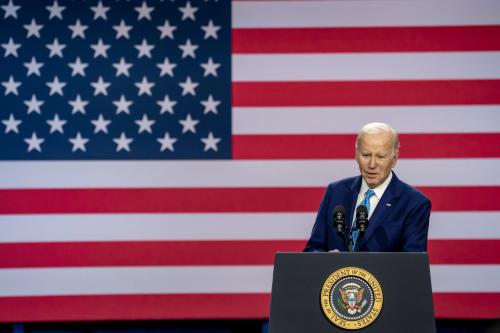The debt limit is once again an issue for political debate about federal spending. In this FixGov blog series, we’ve asked a number of experts to explain why it’s so hard to cut federal spending.
Springtime in Washington D.C. brings out the cherry blossoms and a surge of tourists — along with the recurring game of chicken over the federal debt ceiling. There is a whiff of despair this time with the animosity between Democrats and Republicans threatening to tip the brinkmanship over the edge into a real debt default. Such an outcome — even if only brief — risks pushing up the Treasury’s borrowing costs and jeopardizing the stability of a badly-shaken U.S. banking system.
Logically, it makes little sense to link the debt limit (the amount of debt the U.S. Treasury can issue to pay for spending that has already happened) with next year’s budget. But the Congressional budget process is irretrievably broken. For the fourth time in the past 20 years (2011, 2013, 2017 and 2023) the debt ceiling has triggered budget frustrations that threaten to boil over into a full-blown seismic shock.
The present dysfunction can be traced back to the post-Watergate budget reforms enacted nearly 50 years ago. Historically, budgetary power shifted back and forth between the legislative and executive branches. From 1921 to 1974, the President dominated the budget process. This changed in 1974, when President Nixon decided to “impound” (refuse to disburse) billions of dollars in funds that Congress had appropriated for domestic programs. In a flurry of post-Watergate activity, Congress forced a weakened Nixon to sign the “Budget and Impoundment Control Act of 1974” one month before he resigned under threat of impeachment.
This 1974 law aimed to reclaim Congressional power over the budget. Among many unwieldy rules, procedures and timelines, it created Congressional budget committees layered on top of the existing centers of fiscal power in the Appropriations, Ways and Means, and Finance Committees. It also introduced “sunshine” laws that opened committee hearings to the public, but which inadvertently led to a surge in lobbying by special interests and a decline in the ability to make backroom “in the room where it happened” type deals.
Most budget experts of all political stripes agree that the 1974 reforms have largely backfired. The system has become weaker, less predictable, less capable of reconciling competing demands and more prone to fiscal crises. Prior to 1976, the federal government had never ceased operations for lack of funding. Since then, it has “shut down” 22 times, completely or partially. In addition, during this period there have been only four years (1977, 1989, 1995, and 1997) in which Congress passed its 12 annual appropriations bills on time. Instead, lawmakers rely on short-term spending measures (“continuing resolutions”) ranging from days to months that simply replicate the prior year’s budget to keep the government going. This volatile and unpredictable process means that many federal programs do not have the “steady administration” and “predictability” that Alexander Hamilton laid out as “pillars” of effective government.
Which leads us back to the present debt ceiling impasse. In the past, Congress has always raised the debt ceiling eventually — viewing it as “must-pass” legislation that also enables individual Members to slip in a few spending earmarks at the last minute. But with a slim majority in the House, Republicans are demanding that federal spending be reduced to 2022 levels and future growth capped for the next 10 years. Since this plan excludes defense spending, it would impose draconian cuts on health care, climate, and other domestic programs, while seeking to expand fossil fuel drilling to raise revenue. Even if House Republicans have the votes to pass such measures, it isn’t going to get anywhere with Senate Democrats or President Biden.
The most likely denouement is that Congress avoids default at ten minutes to midnight by using some arcane method (such as a “discharge petition”) or agrees to a very short-term deal to kick the debt limit battle down the road. But the sides are far apart, and any outcome is possible.
The underlying crisis is that Congress has no functioning process for engaging in the difficult but essential work of deciding how to allocate scarce budgetary resources. Even though the debt limit itself has no sensible purpose, it has come to serve as a kind of periodic escape valve. But there is a real cost in wasted time, money and energy that should be spent working to stabilize entitlements, while cutting fat from the defense budget and other priorities.
Getting back to a world of more rational budgetary policymaking requires serious change. This includes both common-sense fixes for the debt ceiling issue (for example, the Bipartisan Policy Center’s proposal to align the debt limit with the annual budget process) as well as fundamental reform to mend and strengthen the budget process.
Restoring a functioning process for budgeting requires a bipartisan effort. Here are some ideas. First, put the government on a two-year budget cycle. The Department of Veterans Affairs already has such a biennial budget to protect veteran’s hospitals and clinics from continual funding uncertainty. The simplest way to minimize budgetary disruption is to extend this cycle to the rest of government.
Second, overhaul the congressional committee structure regarding money. The appropriations and authorizing committees have multiplied into hundreds of subcommittees with overlapping jurisdictions. The budget committees have term limits and limited powers, limiting their effectiveness. We need to restructure and simplify, with committees that oversee both revenue and expenditures for vital programs.
Finally, implement basic effective budgeting tools, such as proper tracking and account for government expenses — costs, overheads, and capital expenditures. These proven techniques will help the federal government improve performance at the same or lower costs.
The core tenet of budgeting is to enable competing interests to compromise. Unless we begin to repair the broken budget process, we will continue to wallow in artificial, self-inflicted debt limit crises.







Commentary
Why is federal spending so hard to cut? — Recurring debt ceiling fights will only be solved by budget reform
April 27, 2023